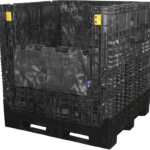Packaging and our environment
 Packaging plays a vital role in the protection and preservation of products during shipping, handling and storage. Companies and organizations are now searching for more environmentally friendly methods to package and ship product.
Packaging plays a vital role in the protection and preservation of products during shipping, handling and storage. Companies and organizations are now searching for more environmentally friendly methods to package and ship product.
The internet is an indirect cause of packaging waste. Thanks to ecommerce, products are being boxed up for individual shipment to consumer doorsteps rather than picked up at a store and carried home. Ecommerce sales have more than quadrupled in the last decade. Bulk deliveries to retail outlets are being replaced (or supplemented by) individual product deliveries to residences. The packaging required for bulk delivery is significantly different than individual product shipment.
Businesses that sell and ship product must go through a balancing act when specifying, designing and creating packaging. The packaging must be functional and protect the product. In many cases it needs to be aesthetically pleasing to attract the consumer. It must be cost effective as this can be a major portion of some products overall cost. And finally it needs to be environmentally friendly. Packaging impacts the environment from its creation as well as disposal. Most packages are disposed of after the product arrives at its destination. While packaging can be considered wasteful, a package that fails to protect the product is a far bigger waste; so packaging that is 100% effective in protecting a product during shipping and storage adds considerable value as the packaging material usually has a much smaller carbon footprint than the products it was designed to protect.
As industry and governments work to reduce the environmental impact of packaging, a number of strategies are emerging.
Reusable: There are a number of variations of this concept. For example: Many grocery stores in Europe are shelving products such as sugar, flour, coffee and other commodities in bulk and having shoppers use their own containers to bring it home. The packaging system rests with the consumer. In other innovations a furniture company is delivering sofas in padded bags that get removed at delivery and reused for the next shipment. Reusable packaging is very common in industrial applications where companies are routinely shipping product back and forth. Some container systems can provide multiple functions such as in-process storage and transport during manufacturing as well as shipping to the customer’s destination.
Redesign: Not long ago, environmental impact was not a major consideration of consumer goods packaging. Now companies are spending significant resources in designing and developing packaging systems that use fewer materials. Packages that use to be combinations of plastic and cardboard are reduced to one or the other. Plastic windows are being replaced by open space. Innovative designs are sleeker and lighter. Today’s packages tend to use a lot less materials than yesterdays’ counterpart.
Recycling: Many packaging containers are recyclable, but consumer buy-in is needed to fully utilize the concept. Packaging materials need to be placed in a recycling bin rather than the garbage. One drawback in many cases is that packaging systems consist of multiple materials laminated together or it may contain food or other residuals making it difficult to segregate. Packaging designers need to consider ease of recycling.
Materials: Some packaging material while recyclable still impact the environment during its creation. Plastic cushioning is one example. A number of Styrofoam replacements use agricultural waste or materials such as wheat straw to mold product cushioning. Source. These materials use less energy to create and they will readily decompose. Unfortunately while there are several startup companies that are emerging with this type of packaging material, they are not readily available in the market place and these substitutes may not be usable in every situation. No doubt that over time and as we collectively demand better environmental solutions these products will become common place. As Susan Selke, interim director of Michigan State University’s School of Packaging stated: “Industry is paying attention, but not enough attention yet” Source.
Packnet engineers and fabricates custom packaging solutions for industrial and commercial applications. We have provided solutions for the medical, machinery, manufacturing, sports equipment, distribution and material handling industries. Packnet is also a leader in creating environmentally friendly packaging solutions.
